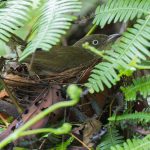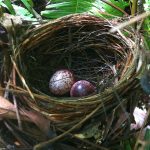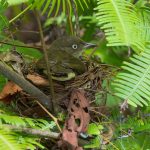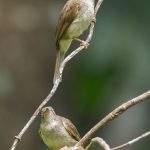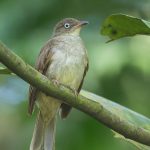The Cream-vented Bulbul (Pycnonotus simplex) is a species of bulbul that has striking white-eyes that are unmistakable. It is found in Thailand, Peninsular Malaysia, Singapore and the Greater Sundas. In Singapore it is a uncommon resident in the forest.
Although breeding has been reported in Singapore before, there isn’t much documentation of the nesting of this species locally or anywhere else.
In June 2011, I had the opportunity to witness the nesting of a pair at the road leading to Upper Peirce Reservoir.
The first encounter on the afternoon of 12th June. I was observing a bulbul perched on a thin branch when it suddenly flew to a Dicranopteris fern (Resam in Malay) patch just a meter off the ground. Although it was partially blocked, I could see that it was sitting on a nest. I observed the bulbul for about 30 minutes when it decided to leave. I took the opportunity to get closer to the nest to get a quick camera phone photo of the eggs. There were two eggs that looked very much like the Yellow-vented Bulbul eggs. About 15 minutes later, the bulbul or its partner returned to incubate the eggs.
On 14th June, I went back to have another look, and I could see that the same routine of perching on a branch and then flying into the fern bush. Approximately half and hour later, a change of shift occurred as the nest was left empty momentarily until presumably another parent took over. See video below.
I went back to check on the 17th June and all was well with a parent incubating the egg in the nest. On the 19th June, both the bulbuls were perched outside of the nest but otherwise all was well. Due to work, my next visit was on the 27th June, but unfortunately, the nest was empty and the bulbuls were nowhere around. Checking on the ground revealed no broken shells, indicating that the eggs were probably taken away elsewhere, presumably by the ever present macaque troops in the area. But that is just a speculation.
It was sad to see an empty nest, but that is nature at work.
The change of shift is captured. Due to the heat of the mid-day sun, the bulbul’s mouth is wide open to dissipate heat.
Photo Gallery
- The red arrow indicate the position of the nest. In the video accompanying this article, you can make out the broad dead leaf that is pictured here.
- The view of the nest was partially blocked, but that is to be expected. If not for the fact that I saw it flying in, I would not have guessed that there was a nest in that position
- The two eggs of the Cream-vented Bulbul. I took two quick shots using my iPhone and the other one turned out blur.
- Just after a shift change.
- The pair of Cream-vented Bulbuls perched near their nest.
- A single Cream-vented Bulbul perched near the nest.

